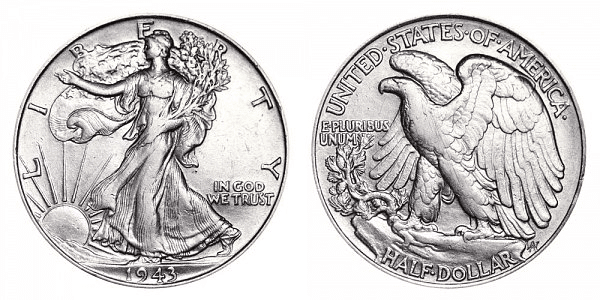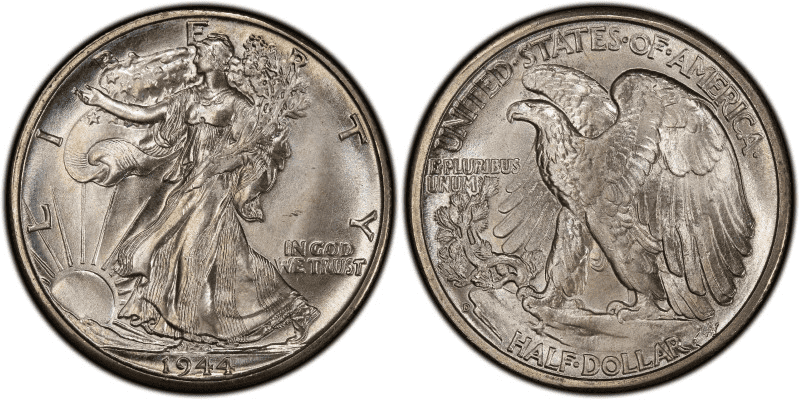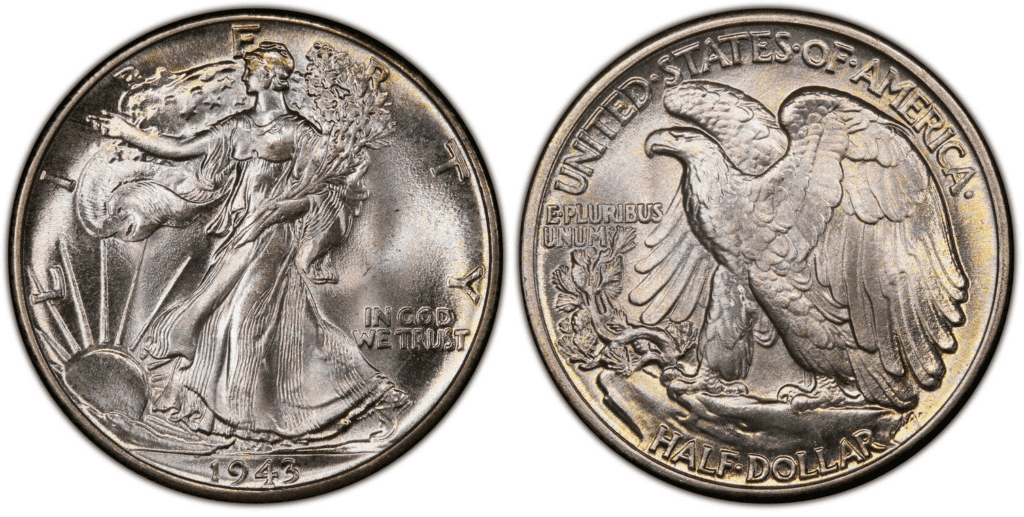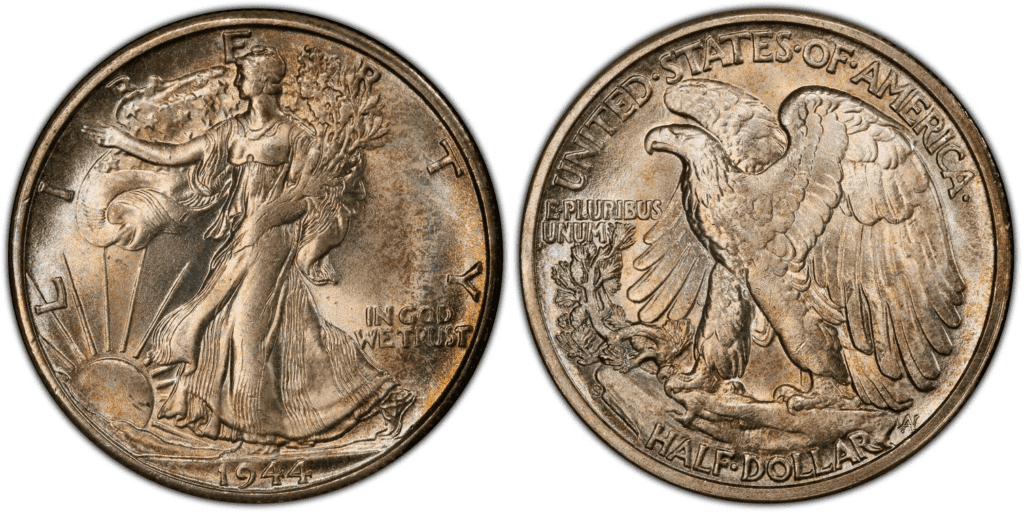The 1943 Liberty half dollar is among the most popular coins today. Thanks to its magnificent obverse and reverse design, it became a top choice among coin collectors. This made the 1943 Walking Liberty 50-cent coin have a premium value that could reach thousands of dollars.
Regarding its composition, the 1943 Walking Liberty half dollar is made of 90% silver and 10% copper. Its actual silver weight (ASW) is 0.36169 troy oz. It has a value of 50 cents, a mass of 12.50 grams, a diameter of 30.63 mm, and a thickness of 1.8 mm, making it among the largest coins issued by the US Mint. It has a reeded edge as well.
The Liberty half dollar was introduced in 1916. It replaced the unpopular Barber coinage. You might have remembered that before 1916, the dimes, quarter dollars, and half dollars bore the same design by Charles Barber. However, it was only at the beginning of 1905 that successive presidential administrations tried to redesign these coins.
Thus, years preceding 1916, there were plans to change the design of the coins, which included the half-dollar. At first, the US Mint produced its own design. However, the Commission of Arts didn’t like the designs they submitted. From there, it was decided to select sculptors to do the job. Adolph Weinman was chosen for his beautiful designs for the half dollar.

Weinman designed both sides of the 50-cent. The same design was used in the first issuance of the Walking Liberty fifty-cent coin, which was the same design used in 1943.
For the 1943 Liberty half-dollar, you’ll find the Liberty Lady walking towards the left while carrying branches of laurel and oak. In the background, you’ll find a glimpse of the US flag. There’s also a rising sun in front of the Liberty Lady.
Inscriptions on the obverse side include LIBERTY, IN GOD WE TRUST, and 1945.
The reverse also has a magnificent design. It features the heraldic bald eagle, which symbolizes the strength and power of the United States. It is perched on a mountain crag where a sapling of mountain pine emerges.
Inscriptions on the reverse side include UNITED STATES OF AMERICA, E PLURIBUS UNUM, and HALF DOLLAR.
1947 was the final year the Walking Liberty half-dollar was issued. The Franklin half dollar was then replaced to honor FDR, the president who led the country through the Great Depression and World War II.
1943 Walking Liberty Half Dollar Varieties
There are three official and standard-struck varieties of the 1943 Walking Liberty half-dollar. These include the following:
- 1943-D
- 1943-P
- 1943-Thesese varieties look the same. The main difference is their mint mark. For example, 1943 half-dollars struck in Denver have the D mint mark, while the ones struck in San Francisco have the S mint mark. On the other hand, the 1943-P or the coins from the Philadelphia mint don’t have mintmarks.
Here’s a quick look at the mintage figure of the 1943 Walking Liberty half dollar:
| Variety | Mint location | Mintage |
| 1943-D | Denver | 11,346,000 |
| 1943-S | San Francisco | 13,450,000 |
| 1943-P | Philadelphia | 53,190,000 |
| Total | 77,986,000 |
The total mintage of the 1943 Walking Liberty half dollar is higher than that of 1944 and 1942.
Here’s a deeper look at the 1943 Walking Liberty half dollar varieties:
1943 D Walking Liberty Half Dollar
Edge: Reeded
Mint Mark: D – at the lower left side of the reverse between the rim and the rock
Place of minting: Denver
Year of minting: 1943
Face Value: $0.50 (fifty cents)
Price: $13 to $51,175
Quantity produced: 11,346,000
Designer: Adolph Alexander Weinman
Composition: 90% Silver, 10% Copper
Mass: 2.5 grams
Diameter: 30.63 mm
Thickness: 1.8 mm

Generally speaking, the 50 cents produced in the Denver Mint were rarer than the 50 cents produced in the Philadelphia Mint. The main reason is that Denver produced fewer coins. The Denver Mint struck more than 11 million 50 cents in 1943.
In 1943, there were more than 11.3 million Walking Liberty coins. Price starts at around $13, and other rare coins can be as expensive as $51,175.
Here’s a deeper look at the 1943 Walking Liberty half dollar varieties:
1943 P Walking Liberty Half Dollar
Edge: Reeded
Mint Mark: No mint mark
Place of minting: Philadelphia
Year of minting: 1943
Face Value: $0.50 (fifty cents)
Price: $13 to $120,000
Quantity produced: 53,190,000
Designer: Adolph Alexander Weinman
Composition: 90% Silver, 10% Copper
Mass: 2.5 grams
Diameter: 30.63 mm
Thickness: 1.8 mm

The Philadelphia Mint produced the most 1943 Walking Liberty half-dollar coins, issuing more than 53 million copies. However, the following year, the mintage figure of this coin was cut in half due to the increasing financial burden placed by World War II.
Because of the high mintage of 1943-P Liberty half dollar, you should easily find them in mint state condition. 1943-P 50 cents are readily available up to a grade of Gem MS65. The coins in the mint state feature a frosty luster.
The 1943-P 50-cent may range from $13 to even $120,000.
1943 S Walking Liberty Half Dollar Proof
Edge: Reeded
Mint Mark: S – at the lower left side of the reverse between the rim and the rock
Place of minting: San Francisco
Year of minting: 1943
Face Value: $0.50 (fifty cents)
Price: $13 to $66,000
Quantity produced: 13,450,000
Designer: Adolph Alexander Weinman
Composition: 90% Silver, 10% Copper
Mass: 2.5 grams
Diameter: 30.63 mm
Thickness: 1.8 mm

The San Francisco Mint produced more than 13 million half-dollar coins in 1943. This mintage figure is higher than the previous year of minting. Compared to the 1945-S and 1946-S, the 1943-S is rarer to find in mint state. Price can reach as high as $66,000.
List Of 1943 Walking Liberty Half Dollar Errors
There were almost 78 million half-dollar Liberty coins struck in 1943. So, it’s not surprising to find some errors in the coins produced.
Each mint center had its own issues with the coins it produced. However, the common problem among the three mint centers is the doubling of their engraved elements. There were instances where they used a doubled master die or a doubled working hub, which resulted in obverse doubling.
Aside from the doubling, some coins had planchet errors. This happened when the planchet was improperly cut. Thus, you’ll find some examples of folded or clipped coins.
Another error is the lamination error. This happens when foreign material is mixed up with silver and copper during the formation of the plancheUnfortunately, theThe foreign material didn’t mix well with silver and copper. As a result, the planchet peeled or cracked.
How Much Is 1943 Walking Liberty Half Dollar Worth Today?
The 1943 Walking Liberty half dollar has a face value of $0.50. Its melt value is $8.6228. This is higher than its face value since the coin was made of silver. This melt value may increase or decrease depending on the market value of silver.
To really understand the value of this coin, check out this 1943 Walking Liberty Half Dollar values chart:
| Coin | Condition | Grade | Mintage | Value |
| 1943 D Liberty Half Dollar | Good | G-4 to G-6 | 11,346,000 | $13 |
| 1943 D Liberty Half Dollar | Fine | F-12 to F-15 | 11,346,000 | $16 |
| 1943 D Liberty Half Dollar | Extremely Fine | XF-40 to XF-45 | 11,346,000 | $18 |
| 1943 D Liberty Half Dollar | Uncirculated | MS-60 to MS-62 | 11,346,000 | $24 |
| 1943 D Liberty Half Dollar | Gem Uncirculated | MS-65 to MS-66 | 11,346,000 | $113 to $288 |
| 1943 D Liberty Half Dollar | Superb Gem Uncirculated | MS-67 | 11,346,000 | $504 to $36,000 |
| 1943 S Liberty Half Dollar | Good | G-4 to G-6 | 13,450,000 | $13 |
| 1943 S Liberty Half Dollar | Fine | F-12 to F-15 | 13,450,000 | $16 |
| 1943 S Liberty Half Dollar | Extremely Fine | XF-40 to XF-45 | 13,450,000 | $18 |
| 1943 S Liberty Half Dollar | Uncirculated | MS-60 to MS-62 | 13,450,000 | $25 |
| 1943 S Liberty Half Dollar | Gem Uncirculated | MS-65 to MS-66 | 13,450,000 | $150 to $516 |
| 1943 S Liberty Half Dollar | Superb Gem Uncirculated | MS-67 to MS-69 | 13,450,000 | $1,864 to $14,400 |
| 1943 P Liberty Half Dollar | Good | G-4 to G-6 | 53,190,000 | $13 |
| 1943 P Liberty Half Dollar | Fine | F-12 to F-15 | 53,190,000 | $16 |
| 1943 P Liberty Half Dollar | Extremely Fine | XF-40 to XF-45 | 53,190,000 | $18 |
| 1943 P Liberty Half Dollar | Uncirculated | MS-60 to MS-62 | 53,190,000 | $20 |
| 1943 P Liberty Half Dollar | Gem Uncirculated | MS-65 to MS-66 | 53,190,000 | $89 to $240 |
| 1943 P Liberty Half Dollar | Superb Gem Uncirculated | MS-67 to MS-68 | 53,190,000 | $528 to $29,375 |
As you can see, the 1943 Liberty half dollar can be worth a lot of fortune. To get an idea of how much it can be sold for, here’s a list of the auction records for each variety:
- $120,000 – a 1943 50C (Regular Strike) coin with a grade of MS68+ sold on June 16, 2021, by Stack’s Bowers
- $66,000 – a 1943-S 50C (Regular Strike) coin with a grade of MS67+ sold on June 2021 by Stack’s Bowers
- $51,175 – a 1943-D 50C (Regular Strike) coin with a grade of MS68 sold on November 2006 by Bowers & Merena
How Does The Grading System Work?
The Sheldon Scale is used by numismatists to provide a numerical value to coins. The Sheldon Scale goes from poor (P-1) to perfect mint state (P-1) (MS-70). Coins were originally evaluated using words to reflect their condition (Good, Fair, Excellent, Etc.). Unfortunately, coin collectors and dealers had different ideas about what each of these terms represent.
Professional numismatists joined together in the 1970s and established CoinGrading standards. These numismatists now assign grades at key places on the seventy-point scale, using the most regularly utilized numeric points in conjunction with the original adjective grade. The following are the most common coin grades:
-
-
- (P-1) Poor – Indistinguishable and probably damaged; if used, must have a date and mintmark; otherwise, rather battered.
- (FR-2) Fair – Nearly smooth, but without the damage that a coin graded Poor often possesses. The coin must have enough detail to be identified.
- (G-4) Fair – Inscriptions have merged into the rims in some areas, and important elements have been mostly erased.
- (VG-8) Very Good- A little weathered, but all of the primary design elements are visible, albeit faintly. There is little if any, central detail left.
- (F-12) Good – The item is very worn, yet the wear is even, and the overall design details stand out clearly. Rims are almost completely isolated from the field.
- (VF-20) Very Fine – Moderately weathered, with some finer features still visible. The motto or all letters of LIBERTY are readable. Both sides of the coin have entire rims that are separated from the field.
- (EF-40) Extremely Fine – Gently used; all gadgets are visible, and the most important ones are bold. The finer details are bold and clear, however, light wear may be seen.
- (AU-50) Uncirculated – Slight evidence of wear on the coin’s design’s high points; may have contact marks; eye appeal should be adequate.
- (AU-58) Uncirculated Choice – Slight traces of wear, no severe contact marks, almost full mint shine, and great eye appeal.
- (MS-60) Mint State Basal – Strictly uncirculated; no indication of wear on the coin’s highest points, but an unsightly coin with reduced luster, visible contact marks, hairlines, and other flaws.
- (MS-63) Mint State Acceptable – Uncirculated, but with contact scratches and nicks, little reduced shine, but otherwise appealing appearance. The strike is weak to average.
- (MS-65) Mint State Choice – Uncirculated with great mint shine, very little contact blemishes, and exceptional eye appeal. The strike is unusually severe.
- (MS-68) Mint State Premium Quality – Uncirculated with superb luster, no obvious contact marks to the naked eye, and exceptional eye appeal. The strike is quick and appealing.
- (MS-69) Almost Perfect Mint State – Uncirculated with perfect brilliance, a sharp and appealing strike, and extremely good eye appeal. A near-perfect coin with minor imperfections in the planchet, strike, and contact markings (seen only under 8x magnification).
- (MS-70) Mint State Perfect – Under 8x magnification, there are no tiny imperfections discernible; the strike is crisp, and the coin is perfectly centered on a beautiful planchet. Rarely seen on a coin, this coin is bright and whole, with original luster and exceptional eye appeal.
-
Where To Buy Or Sell 1943 Walking Liberty Half Dollar?
You can buy or sell 1943 Walking Liberty half dollars online and in shops or auctions.
Living in the digital age, you can easily find websites that will help you buy or sell coins. The most popular websites include JM Bullion, USA Coin Book, Grey Sheet, and Golden Eagle Coins.
Aside from these specialized websites, you can head to marketplace platforms such as eBay and Amazon. Although, eBay seems to have more listings of coins than Amazon.
You can also try social media. For example, you can look for forums and groups interested in coins.
The Internet is a quick and easy place to buy and sell 1943 50 cents. However, there could be some disadvantages. For one, you can’t physically hold and see the coin. Plus, there are scammers online that might try to fool you.
So, if you’re not comfortable selling or buying online, you can visit coin shops, antique stores, and auction houses. Be sure to work with reputable and trusted people to ensure you’re safe from scams.
FAQs
Where is the mint mark on a 1943 Walking Liberty Half Dollar?
The mint mark on a 1943 Walking Liberty half dollar is on the reverse side of the coin. Look for it on the lower left side of the coin. It should be found under the rock where the eagle is standing. Mint marks can either be S or D. Coins from the Philadelphia Mint don’t have a mint mark.
Are there any rare Walking Liberty half dollars?
The 1916-S Liberty half-dollar coins are considered rare because it has the lowest mintage among all the Walking Liberty series. Aside from that, Walking Liberty, with a grade of MS68 and above, should also be considered rare because there are only a few of them that exist today.
Is a 1943 D Walking Liberty worth anything?
Yes, the 1943 D Walking Liberty can be worth a lot of money. Although its face value is 50 cents, it has a higher melt value of around $8. Aside from that, its numismatic value is even higher. Just to give you an example, a 1943 D with a grade of MS6 was sold for $51,175 in November 2006.
